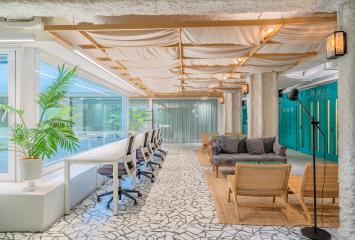How to Maintain a Cool and Healthy Office Environment During Summer
Professional performance depends on both cognitive abilities and mood. Both human dimensions can be affected by environmental conditions. Extreme heat, in particular, leads to increased discomfort, higher stress levels, and a reduction in cognitive skills such as working memory and reaction times. In this regard, there is a dual motivation for wanting to maintain a cool environment in offices during the summer months: the well-being of employees and the success of the company. We have many strategies available to achieve this beyond the indiscriminate use of air conditioning.
Bioclimatic Design: Leveraging Natural Conditions
Each environment on Earth has specific climatic characteristics. Instead of fighting against them, of implementing generic solutions independent of the environment, bioclimatic design proposes leveraging these characteristics to optimize thermal comfort with minimal use of HVAC systems. This includes considering the amount of sunlight entering or the orientation of windows. Bioclimatic design also makes use of artificial strategies such as selecting construction materials with insulating properties. Good bioclimatic design significantly reduces a building's carbon footprint.
Colors: More Than Just Aesthetic Appeal
Colors make a significant difference in the aesthetic result of an office. It's important to choose them well to create an atmosphere that is both relaxing and stimulating. Colors have a strong emotional impact on people. However, colors also play a role in the temperature of the building: some colors absorb heat, while others have the ability to reflect more or less solar radiation and dissipate heat. Likewise, the use of reflective materials in key structures such as walls or ceilings can lead to a more moderate natural temperature inside the office.
Ventilation: Natural Cooling Without Emissions
Natural ventilation has several advantages over artificial ventilation: it does not produce greenhouse gas emissions that exacerbate global climate issues, it does not require energy consumption, it has no economic cost in its operational phase, and it is also much healthier. Among other things, it combats the accumulation of microorganisms in the environment and eliminates ambient humidity. To promote natural ventilation, it is necessary to harness air currents and encourage natural circulation through strategically placed windows. Ceiling or pedestal fans can also be good supports to minimize the use of air conditioning.
Shade: An Ally in Reducing Thermal Load
Shaded areas are essential during the summer months, especially in areas where maximum temperatures reach or exceed thirty degrees Celsius. In this regard, it is recommended that office buildings have elements such as awnings, curtains, or blinds that block direct solar radiation during peak hours. When it is not possible to do this throughout the entire office, it is advisable to design shaded spaces where office users can cool off temporarily or, if it is a flex office-based environment, stay there as long as they wish.
These measures, combined with healthy individual practices such as wearing appropriate clothing for this time of year or staying hydrated regularly, are sufficient to minimize the office's dependence on air conditioning. In any case, it is unlikely that this dependence will be zero, and there will always be moments when it is essential, even if at a moderate intensity. This is precisely why it is crucial to conduct regular inspections of the air conditioning system to ensure its proper functioning and avoid excessive energy consumption. For economic reasons, yes, but also for sustainability.

